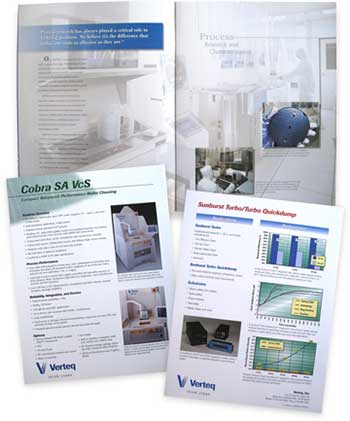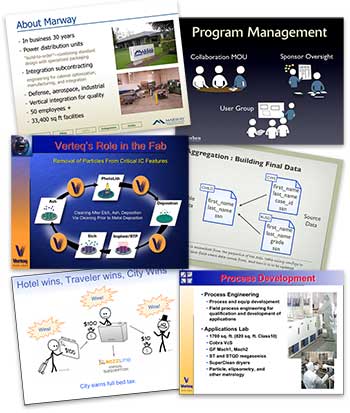my sales tools work started in 1988 with PageMaker 3 and Illustrator 88 and a simple 4-page product handout. Since then I’ve used many applications, but more importantly I studied graphic design and communications to improve the effectiveness of the materials I created.
form follows function
You’ll notice I picked the label sales tools for this section, and that’s because that has been the focus and purpose of the graphic arts and desktop publishing work I have done. I started out trying to create visually compelling works of art until I realized I could get more done, and provide more value by focusing on providing information in a direct and effective format. After all, the purpose was for sales people to communicate quickly and clearly with their clients, not win art contents. This doesn’t means pieces can be ugly. Far from it. Communications materials need to look professional and well crafted, or the content will be ignored to start with.
I have worked primarily in technology industries, so I tend to use a simple approach to design with just enough flair to look like the material was important enough to be cared about when it was created. Organization, eye path, and balance are the key ingredients to presenting information which can be quickly absorbed and understood.
you have permission, use it
In today’s advertising saturated environment, where most messages are lost in the noise, sales tools such as brochures, presentations, videos, and web sites differ from advertising in their opportunity to deliver your company and/or product message. With these communication media, you can assume the person has made some choice to review the material. Be it a glance, or a decision to spend some time researching, you have the person’s attention with permission. You want to make the most of it.
Regardless of the specialties which various media offer in delivering messages, all communications efforts start with an understanding of the purpose of the material. First and foremost is knowing the target audience. Is the person in a technical or financial role? Is the person expected to be intimately familiar with this type of product? Is the person expected to be familiar with the company? Within the scope of that audience, the content of the material can then be clearly defined, and the marketing messages can be prioritized.
The content of any marketing communications should be developed and designed to reflect the reader’s motivations for interest in the product. The product should have been designed to fulfill specific motivations, and a sales tool piece is the place to articulate the design choices made during product development, and why. If the focus of communications is placed on the buyer’s motivations (be it quality, price, or technology), then there will be a greater sense that your company’s product meets that need.
For example, if your product was designed to address the buyer looking for durability, then focusing sales materials on convenience or ease-of-use is counter productive. The product may in fact be very convenient, but if the market plan was to attract buyers whose differentiating motivation was durability, don’t waste time emphasizing convenience. All features important to the product should be mentioned, but often buyers will assess features outside their primary interest as essentially the same among competitive products. A simple mentioning of them will suffice. Products with strong single-purpose identities are no accident. They are created through focus in marketing messages and supporting sales materials.
Sales tools of all forms should also support the corporate positioning. This does not mean adding overview corporate statements to detailed product pieces, but product descriptions and features can be phrased or prioritized to help support corporate and product positioning. Once audience and messages are defined, the needs required to convey those messages in a compelling manner are established, and decisions regarding media can be addressed.
brochures
Brochures can be as brief or as lengthy as costs and purpose dictate. However, in all cases, by using graphics, text, color, and design, a brochure should be able to deliver the intended positioning of the company and product in less than five seconds. If in that five seconds, the reader’s attention is caught, it should take no more than another five seconds for the reader to recognize whether the brochure will answer his questions, and where the answers are.
video
With the ability to show action, space and time, and with the support of audio, videos are the most effective way to capture an action-oriented product’s energy, or to deliver a compelling emotional, lifestyle, or personality association with a company or product. To have a positive impact, video must provide visually interesting and informative subjects. A video of charts and graphs will fail to deliver the expectations the viewer has in acquiring information unique to what video can offer. To best apply video, determine what information in the marketing messages is best delivered by this medium. Use printed material to support the video with data or specifications best shown in printed form, as well as to provide an easy reference.
web sites
Whether your business serves a local, regional, or global customer base, an internet web site is virtually a requirement in a company’s arsenal of sales tools. A web site is available to your customers at their convenience at any time of any day. Providing a high quality and informative web site declares your commitment to meeting their needs as effectively as possible.
repetition and reinforcement
Business to business sales cycles are usually lengthy; taking time to execute a number of iterative discussions in finer detail. For marketing, this process requires paying attention to two principles: repetition and reinforcement. It is inevitable that multiple discussions will take place during the sales cycle. Repetition will be essential to ensuring that the seller’s positioning and primary marketing messages are remembered. Additionally, discussions with the varying buying influencers should all reinforce each other. Production concerns about durability should be reinforced with technical discussions about material and component quality, which can be reinforced with financial data on low cost of ownership. Detailed discussions of these may be with separate people, but some cross-mention of each will help ensure a reinforcement of the marketer’s messages when the buyer’s two parties discuss the product.
For most purchases, people want to make an informed decision. The more information required, the more effort needs to be put into providing various informative perspectives. From quick overviews and detailed specifications and performance assessments, to information tailored for specific types of buyers or decision influencers. However, most people want to spend as little time as possible in acquiring the most pertinent information.
Multiple sales tools dedicated to specific concerns or audiences will be more successful in delivering the company’s messages than a single all-encompassing reference. This dictates a layered approach in separating overview from detail, and technical from fiscal issues. An overview brochure or video might outline the major qualities or features of the product. Here the primary positioning messages should be uniform, with secondary messages focusing on buyer perspective. A set of subordinate pieces would provide more detailed specifications or technical or financial performance assessment. In each layer, positioning messages should be uniform (even if presented in a different manner), and each piece should be developed knowing what information the others contain.
Invariably, each person in the buying process will end up acquiring multiple sales tools pieces throughout the sales cycle. Leverage that opportunity to provide something a little different each time. Repetition improves recall, and the reinforcement builds believability.
Additionally, the reinforcement efforts should be supported by trade shows, articles in trade journals, independent studies and other forms of third-party documentation whenever possible.





